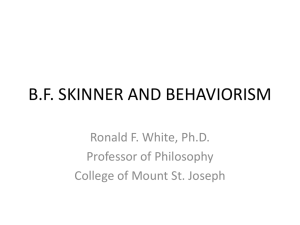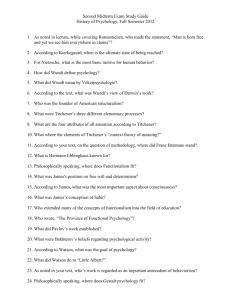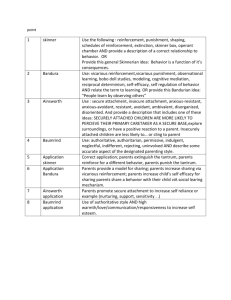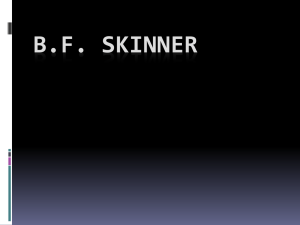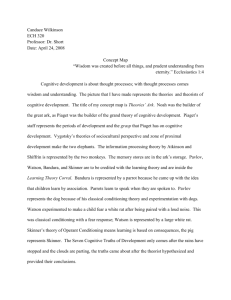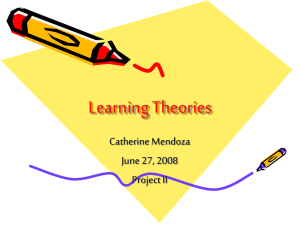History of Psychology Behaviorism: After the Founding Chapter 11
advertisement
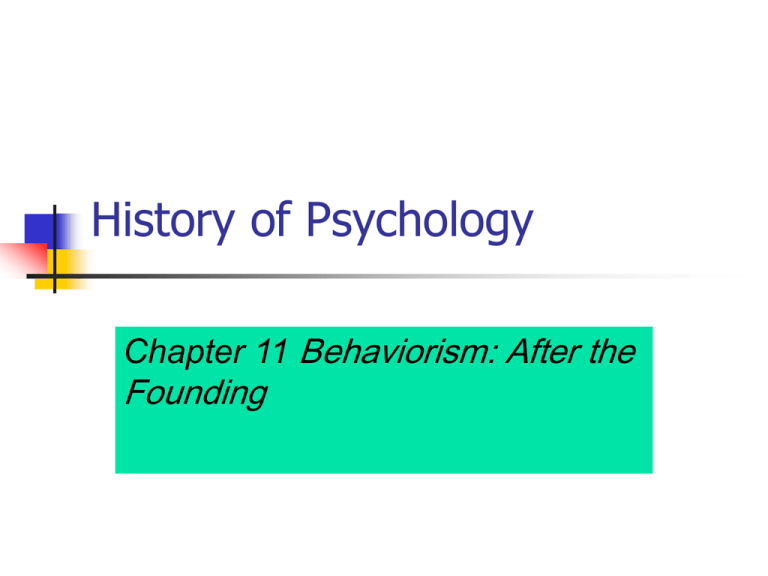
History of Psychology Chapter 11 Behaviorism: After the Founding I. Three Stages of Behaviorism A. Periods 1. 1913-1930: Watsonian behaviorism Watson 2. 1930-1960: neobehaviorism Tolman, Hull, and Skinner 3. 1960-present: sociobehaviorism and cognitive processes Bandura and Rotter Three Stages of Behaviorism B. 1930-1960: neobehaviorism a. core of psychology is the study of learning b. most behavior can be accounted for by the laws of conditioning c. psychology must adopt the principle of operationism II. Edward Tolman (1886-1959) A. Career 1. studied engineering at MIT 2. studied psychology at Harvard: Ph.D. in 1915 3. 1912: studied with Kurt Koffka Edward Tolman (1886-1959) 4. graduate school a. trained as Titchenerian structuralist b. questioned scientific usefulness of introspection c. became acquainted with Watsonian behaviorism, but later dissatisfied with his approach 5. Instructor at Nrothwestern U. and later U of California at Berkeley Edward Tolman (1886-1959) B. Purposive behaviorism 1. 1932: Purposive Behavior in Animals and Men 2. Reject introspection and no interest in internal experiences. 3. Purposive behaviorism: Combining the objective study of behavior with the consideration of purposiveness or goal orientation in behavior. (all actions were goal-directed) Edward Tolman (1886-1959) C. Intervening variables 1. the initiating cause and the result must be observable and operationally defined 2. intervening variables a. are the actual determinants of behavior b. internal process that connect the stimulus situation with observed response c. S-O-R (O: Organism), not S-R d. cannot be objectively observed e. intervening variable: e.g., Hunger Edward Tolman (1886-1959) D. Learning theory 1. rejected Thorndike’s law of effect a. reward has little influence on learning 2. repeated performance of task strengthens learned relationship between environmental cues and organism’s expectations Edward Tolman (1886-1959) 3. cognitive map animal establishes a cognitive map (e.g., a comprehensive picture of the maze) 4. latent learning: Learning cannot be observed at the time that it is occurring learning without reinforcement III. Clark Leonard Hull (1884-1952) A. Hull’s life 1. U. of Wisconsin: studied mining engineering before psychology 2. 1918: Ph.D. from Wisconsin 3. 1929: research professor at Yale Clark Hull (1884-1952) 4. theory of behavior based on Pavlov’s laws of conditioning a. 1943: Principles of Behavior A comprehensive theoretical framework to account for all behavior f. 1952: A Behavior System Continued to revise his system and incorporating the results of his research. This book is the final form of his system Clark Hull (1884-1952) B. The spirit of mechanism 1. Describe human behavior as a. mechanistic, robotic b. automatic 2. machines could be constructed that would display human cognitive functions Clark Hull (1884-1952) C. Objective methodology & quantification 1. Objective: experimental methods 2. Quantitative: using the precise math languages 3. four methods for scientific research a. simple observation b. systematic controlled observation c. experimental testing of hypotheses Clark Hull (1884-1952) d. the hypothetico-deductive method 1) establish postulates from which experimentally testable conclusions can be deduced 2) submit them to experimental test 3) if not supported by experimental evidencethey must be revised. 4). If supportedincorporated into the body of science. 5). method necessary for psychology to be a science Clark Hull (1884-1952) 3. primary drives a. arise from a state of physical need (e.g., food, water, air) b. are vital to the organism’s survival 4. secondary drives a. are learned b. are situations or environmental stimuli associated with the reduction of primary drives c. as a result of the association, become drives themselves Clark Hull (1884-1952) E. Learning 1. has a key role in Hull’s system 2. focuses on principle of reinforcement (Thorndike’s law of effect) Clark Hull (1884-1952) F. S-R connection 1. habit strength 1) the strength of the S-R connection 2) is a function of reinforcement 3) refers to the persistence of the conditioning 2. learning cannot occur without reinforcement IV. B. F. Skinner (1904-1990) A. Skinner’s life 1. Born in Pennsylvania 2. Life is a product of past reinforcements 3. 1925: Hamilton College (NY): degree in English and desire to be a writer, no courses in psychology B. F. Skinner (1904-1990) 4. read about Pavlov’s and Watson’s work 5. 1931: Ph.D. in psychology from Harvard 6. Taught at the U. of Minnesota and Indiana U. 7. 1953: Science and Human Behavior (basic book for his approach) 8. 1990 (final article): "Can Psychology Be a Science of Mind?“ B. F. Skinner (1904-1990) B. Operant conditioning 1. operant behavior a. rat presses the bar and then gets food. b. this type of behavior is the more representative of everyday learning 2. the "Skinner box": study the rate of response B. F. Skinner (1904-1990) 3. law of acquisition a. key variable: reinforcement b. practice itself will not increase the arte of responding c. practice provides opportunities for additional reinforcement to occur B. F. Skinner (1904-1990) C. Schedules of reinforcement 1. reinforcement is necessary in operant behavior 2. reinforcement schedules: conditions involving various rates and times of reinforcement a. continuous b. fixed and variable c. ratio and interval B. F. Skinner (1904-1990) D. Verbal behavior 1. The verbal behavioral responses can be reinforced by speech sounds or gestures 2. Parents’ behavior: Parents give different responses to their child’s unacceptable words or polite words B. F. Skinner (1904-1990) E. Skinner’s book: Walden Two (1948): A behaviorist society 1. An attempt to apply his findings to society as a whole. 2. Assumption: human natures is machinelike. B. F. Skinner (1904-1990) F. Behavior modification 1. Definition: The use of positive reinforcement to control or modify the behavior of individuals or groups. 2. used in a variety of applied settings 3. reinforce desired behavior and not reinforce undesired behavior 4. punishment is not used B. F. Skinner (1904-1990) G. Applied Animal Psychology: The IQ Zoo Two Skinner’s students applied operant conditioning from lab to the real world They train animals to perform tricks for state fair and animal shows, and then open the IQ zoo for tourists. B. F. Skinner (1904-1990) I. Contributions of Skinner’s behaviorism 1. shaped American psychology for 30 years 2. his goal: the improvement of society 3. strength and ramifications of his radical behaviorism 4. APA: the Distinguished Scientific Contribution Award (1958); Life time Contribution to Psychology (1990) 5. 1968: National Medal of Science V. Social Learning Theories: The Cognitive Challenge A reflection of the broader cognitive movement in psychology as a whole VI. Albert Bandura (1925 - ) A. Background 1. Born in Canada 2. 1952: Ph.D. from U. of Iowa 3. Joined the faculty of Stanford U. Albert Bandura (1925 - ) B. Social cognitive theory 1. A less extreme form of behaviorism 2. focus: observation of the behavior of humans in interaction 3. emphasizes the role of reinforcement in modifying behavior Albert Bandura (1925 - ) 4. stresses the influence on external reinforcement schedules of thought process (e.g., beliefs or expectations) 5. Responses are not automatically triggered by external stimuli, like a machine; 6. instead reactions to stimuli are selfactivated; the person is consciously aware of the response. Albert Bandura (1925 - ) 7. reinforcer effective if a. person is consciously aware of what is being reinforced b. person anticipates the same reinforcer if the behavior is repeated Albert Bandura (1925 - ) 7. vicarious reinforcement: a. definition: Learning can occur by observing the behavior of other people, and the consequences of their behavior, rather than by always experiencing reinforcement personally. Albert Bandura (1925 - ) b. Assumes human capacity to anticipate consequences we observe in others, even though we have not experienced them ourselves c. One can regulate one’s behavior by 1) imagining consequences of a particular behavior 2) making a conscious decision to behave or not d. is like the S-O-R model, with O = cognitive processes Albert Bandura (1925 - ) 8. cognitive processes distinguish Bandura’s from Skinner’s views a. actual schedule of reinforcement less important than what the person believes it to be b. who controls behavior 1) Skinner: whoever controls reinforcers 2) Bandura: whoever controls the models in a society; we learn through “modeling” Albert Bandura (1925 - ) C. Self-efficacy 1. Definition: One’s sense of self-esteem and competence in dealing with life’s problems. 2. Our belief in our level of self-efficacy influences many aspects of our lives. 3. Low self-efficacy: helpless, hopeless, no control over their lives, little chance… Albert Bandura (1925 - ) D. Behavior modification 1. If all behaviors are learned by observing others or modeling others, then undesirable behaviors can be relearned in the same way. 2. Bandura’s goal: change or modify socially undesirable behavior 3. Focus on external aspects of abnormality (i.e., focus on behavior instead of internal conscious conflict) Albert Bandura (1925 - ) 4. the use of modeling techniques e.g., being afraid of dogs; prevention program on radio or TV (preventing unwanted pregnancies) 5. Behavior therapy E.g., using in clinical (OCD, sexual dysfunctions, phobias, or some from of anxiety), business, or classroom Albert Bandura (1925 - ) E. Comment 1. criticisms a. Traditional behaviorists criticized that cognitive processes do not cause behavior 2. positive aspects of Bandura’s social cognitive theory a. consistent with the functionalism of American psychology b. objective c. responsive to current Zeitgeist (cognitive) d. applicable to practical problems VII. Julian Rotter (1916 - ) A. Background 1. Grew up in New York. 2. His family lived comfortably until his father list his business in 1929 (in his age of 13) VII. Julian Rotter (1916 - ) 3. Wanted to become a psychologist but major in chemistry at Brooklyn College 4. met Adler and switched to psychology 5. 1941: Ph.D. from Indiana U. 6. Worked at a State mental hospital, and then Ohio State U. (until 1963), and then U. of Connecticut Julian Rotter (1916 - ) B. Cognitive processes 1. 1947: the first to use the term "social learning theory" 2. cognitive approach to behaviorism 3. invokes the existence of subjective experiences Julian Rotter (1916 - ) 4. criticized Skinner for studying single subjects in isolation; Rotter studied human subjects in social interaction 5. relies on rigorous, well-controlled lab research Julian Rotter (1916 - ) 6. deals with cognitive processes more extensively than Bandura a. Behavior is determined by both external stimuli and the reinforcement they provide, but the influence of these two factors is mediated by our cognitive processes Julian Rotter (1916 - ) C. Locus of control 1. beliefs about the source of one’s reinforcements 2. internal versus external locus of control Internal locus of control is the belief that reinforcement depends on one’s own behavior; external locus of control is the belief that reinforcement depends on outside forces. Julian Rotter (1916 - ) 3. Internal locus of control: physically & mentally healthier, perceived greater freedom of choice… 4. Is learned in childhood from parents’ behavior 5. Locus of Control measure: 23 forced-choice many of the unhappy things in peoples’ lives are partly due to bad luck People’s misfortunes result from the mistakes they make Julian Rotter (1916 - ) D. Comment Rotter’s social learning theory have attracted people who agree on the importance of cognitive variables in influencing behavior. Locus of control: one of the most studies variables in psychology VIII. The Fate of Behaviorism Few scholars at major university now call themselves behaviorists in the traditional sense. However, behaviorism invoking the internal cognitive processes is still growing

